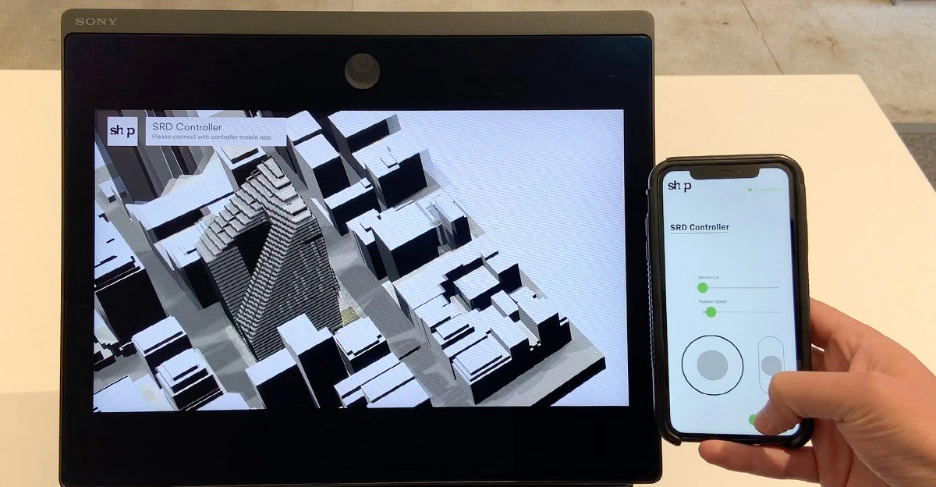SHoP Architects: Building on Sony’s Spatial Reality Display
A creative leader and technology innovator, SHoP Architects developed a smartphone app to help clients experience the firm’s 3D designs on Sony’s Spatial Reality Display1,2.
How we helped

The challenge
- Communicate 3D design concepts to clients, consultants, contractors and other stakeholders.
- Enable the viewer to curate her own 3D walk-throughs, moving the point of view, changing the angle of view and even “sectioning out” 3D cutaways.
- Communicate subtle textures, colors, and light effects to complement SHoP’s existing VR/AR applications and CAVE automatic virtual environment.

The solution
- Connect SHoP’s vast library of 3D assets in the Unity graphics engine to Sony’s Spatial Reality Display3.
- Create a remote-control app with a graphic user interface that empowers the viewer to guide the experience.
*1 Computer required with a recommended CPU of Intel Core i7-9700K @3.60GHz or faster; and a graphics card such as NVIDIA GeForce RTX 2070 SUPER or faster.
*2 See instruction manual accompanying the product for details on product use, incl. 3D feature.
*3 Recommend use of “high resolution, quality images” created using Unity or Unreal software.

The outcome
- Enables highly accurate, impressively detailed 3D visualization.
- Communicates spatial relationships in ways that no other display technology does.
- Generates excitement, enthusiasm and buy-in among stakeholders.
Spatial Reality Display Controller Video
Quotes:
“This is mind blowing. It helps our clients dig deeply, gaining a comprehensive understanding of 3D design.”
- Adam Chernick, director, interactive visualization, SHoP Architects
A new way to visualize architecture
You might expect an architecture practice with a substantial investment in VR/AR and a CAVE automatic virtual environment to be reluctant to take on a dramatically different volumetric 3D display. But SHoP Architects did exactly that. “While we have a cylindrical CAVE installation and established applications for VR and AR, the Spatial Reality Display gives us a very different type of immersive experience,” says Adam Chernick,director of interactive visualization. “It’s not AR. It’s not VR. It’s a ‘hologram,’ as if the object were right there before us.”
“We’re wary of technology that’s cool but not useful,” explains Chernick. “It’s got to increase efficiency, save time, reduce clicks or improve communication. The Sony display checks every box. It’s a very clean, easy-to-use experience that helps clients better understand the project.”
Chernick is so impressed with the Spatial Reality Display that his group has created a feature called the “SRD Controller” for SHoP Portal, their Android® and iOS® mobile app [MM1] that enable the user to control the SRD. Communicating to the host PC via OSC (Open Sound Control) protocol, the app enables the user to intuitively move about architectural models, pivot the point of view, explode assemblies into component parts and cut 3D slices for cross-section views. The SRD controller is embedded within the firm’s mobile app which also gives internal teams and stakeholders the ability to receive project information and 3D models from anywhere.

Innovation in architecture
Honored by multiple awards, SHoP completed such acclaimed projects as the Barclays Center sports arena in Brooklyn and the Uber Headquarters in San Francisco. Projects range from public spaces like Mitchell Park to super-tall residential towers currently under construction: 111 West 57th Street in Manhattan and 9 Dekalb Avenue in downtown Brooklyn.
Just as eye-opening is the firm’s use of technology. “From the very beginning, our founders believed that architectural documentation and construction were behind the times,” says Chernick. “We’ve been inspired by automotive and aerospace design processes with DTM [direct-to-manufacturing] workflows that replace conventional blueprints, speeding up fabrication. We use computer-based generative design to optimize results. To validate and fine tune our designs, our in-house prototyping and fabrication shop includes an industrial robot and a CNC [computer numerically controlled] machine.”
Easy integration, high performance
The Sony Spatial Reality Display enables viewers to see volumetric 3D without special glasses or VR goggles. 1,2 The display works from computer generated images, in the case of SHoP Architects, using a Windows® PC running the Unity® rendering engine. 3The screen features a high-precision micro-optical lens to separate the left-eye and right-eye images. In addition, the display tracks eye movement down to the millisecond, pivoting the image in sync as the viewer tilts or moves the head up and down, left and right — even forward and back. The result is an overpowering sensation of a solid 3D object.
Integrating the Sony display into the firm’s workflow was simple and direct. Says Chernick, “95% of our projects are already using Unity. And using the display is incredibly easy. It automatically finds your face, locates your eyes and gives you a sharp, clean image, as if the object were right in front of you. When we show this to clients, engineers and consultants, there’s a real wow factor — lots of excited faces. In fact, one of our real estate clients wants a Spatial Reality Display of their own to previewapartments.”

